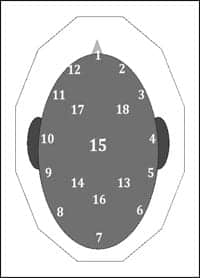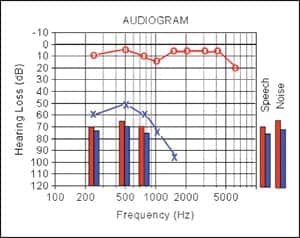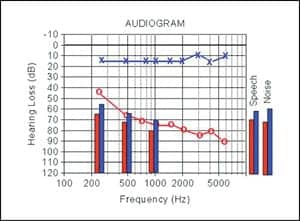The clinical tradition for hearing assessment is to first separate the two naturally communicating acoustical sensors (ears), and then to measure them independently. But what if auditory balance is a key metric in our perception?

|

|
| This article was submitted to HR by H. Christopher Schweitzer, PhD, director of HEAR 4U International, Lafayette, Colo, and chief audiology officer for Able Planet, Wheat Ridge, Colo, and Desmond A. Smith, research scientist at Acoustimed (Pty) Ltd, Johannesburg, South Africa, and director of digital signal processing for Able Planet. Correspondence can be addressed to . | |
It is well established that large individual differences exist in loudness growth patterns among listeners with sensorineural hearing loss.1-7 When inter-ear differences occur, as in cases of asymmetrical hearing sensitivities, the uncertainties related to balanced auditory perception with unequal peripheral hearing capacities are further magnified in unpredictable ways.
Recent investigations with several listeners with asymmetrical sensorineural hearing loss are illustrative of this uncertainty and simultaneously supportive of the utility of a balance control on consumer headphones for musical entertainment listening.8 This article describes the rationale for a prototype proprietary product, In Balance™, from Able Planet, and provides details on measurements for several subjects. It speaks to the high value that nature assigns to the principle of auditory balance (ie, audition rather than to vestibular function)—even when injury and medical mishaps conspire to disrupt it.
Questions on Binaural Balance
The nonlinear properties of cochlear hearing impairment are generally well understood by audiology professionals. The pattern observed is typically characterized by what appears to be a steeper growth of loudness function than for normal-hearing listeners as illustrated in Figure 1. Classically labeled as “recruitment,” recent studies present a compelling case that it is essentially an aberration of threshold loudness, rather than a distortion of the growth of loudness.2-6

|

|
| FIGURE 1. Generalized representation of classical “Growth of Loudness” patterns suggesting steeper-than-normal function for sensorineural hearing impairment. Recent research attributes this type of pattern to “softness imperception” as described by Florentine.6 | FIGURE 2. Behavior pattern for ears of a patient with unilateral sensorineural impairment (Subject AA) showing a similar nonlinear loudness discontinuity as in Figure 1. In this case, the subject has an asymmetrical auditory sensitivity. |
It is perhaps less well understood whether such level-dependent irregularities with cochlear injuries manifest within an individual’s hearing experience when only one ear is damaged or when one ear is more severely damaged than the other. For example, do large threshold differences resolve into much smaller differences at comfortable listening levels for entertainment and/or communication? Figure 2 illustrates this pattern representative of one of the subjects described more fully in the text.
A related question is whether binaural perception of signals for unilateral or asymmetrical sensorineural impairments can still produce “center of the head” lateralization or stereophonic listening experiences. Furthermore, do acoustically dichotic signals of stereo music presented via headphones converge to an enjoyable auditory experience if and when the levels at the two ears can be independently adjusted for ears of dissimilar audiometric sensitivity?
Challenges in Asymmetrical Losses

|
| FIGURE 3. Measurement scenario for determining the relative dBSPL differences between headphones when subjects adjusted the music from a digital player to a center-of-head position. |
Asymmetrical hearing loss patterns with differences of 35 dB or greater are understood to present diagnostic challenges of masking in order to isolate the more severe ear. They also result in considerable uncertainty relative to inter-ear differences at supra-threshold levels.
In cochlear-based asymmetries, there is the strong likelihood that differences between ear responses at threshold—especially in the case where one ear is essentially normal hearing—will show considerable “catching up” at supra-lateralization during bilaterally presented sound stimuli, such as in the use of headphones for entertainment. Typical listening levels for such purposes are, of course, considerably more intensive than barely audible (threshold) levels.
Therefore, the availability of a reliable balance control may notably improve the stereo listening enjoyment of unilaterally impaired or asymmetrical listeners. A prototype unit of a new Able Planet In Balance control inserted into the audio cable was used as part of a pilot investigation of these properties of unilateral and asymmetrical loss conditions.
Methods

|
| FIGURE 4. Illustration of the numbering chart used by the subjects to locate the sensory experience for the various signals. Subjects were encouraged to adjust (or have the experimenter adjust) the relative left-right levels until a number 15-position was experienced. |
Three subjects with varying asymmetrical sensorineural hearing loss are included for discussion. Their differences, in terms of history and perception, are as illustrative as their commonality of having one ear notably better hearing than the other.
Conventional right and left ear thresholds were determined, and a series of balancing measures were obtained for tones, pink noise, and music. Simple lateralization tasks were conducted for the three subjects using a Frye Fonix 10A audiometer calibrated with TDH 39P headphones. The subjects were asked to assist by verbal report in adjusting the relative presentation in 5 dB and 2.5 dB steps. For music, noise-cancelling headphones (Able Planet NC-200) were used, and music was delivered via a digital player. The experimental balance control was adjusted by the subject while music was simultaneously routed to an identical set of headphones for sound level meter (SLM) measures of the relative dB between the left and right headphones as shown in Figure 3.
For the audiometric measures, values were not recorded until the subject achieved the same balanced levels on three consecutive adjustment trials. A numbered head position chart (Figure 4) was present to assist the subject in locating and adjusting signals to a center point.
Subject AA. AA was a 49-year-old female with a congenital, severe sensorineural impairment of the left ear. As shown in Figure 5, the right ear was essentially normal.
The masked air conduction thresholds for the left ear are obviously severe. It is evident that she has a difference for her left/right hearing threshold levels (HTLs) for frequencies 250, 500, 750, 1000, and 1500 Hz of about 60 dB. This subject has worn a hearing aid in the deficient ear for over 20 years. Hence, her considerable experience with unilateral amplification and sensory stimulation presumably has a bearing on her perceptual reports for these observations.
Figure 5 also shows the plotted difference levels for selected signals at which balance sensations were achieved. The results are striking examples of the previously mentioned “catching up” behavior for the several frequencies tested. It was clear for this subject that a significantly smaller amount of difference for presentation levels to the two ears was required to achieve a sense of “center of the head” lateralization experience for tones, speech, and music at comfortable listening levels (CLL) than implied by the threshold audiogram. An experience of binaural auditory perception was clearly achieved—both surprising and curiously amusing the subject.

|
| FIGURE 5. Threshold and plotted examples of levels to achieve balances for selected signals for Subject AA. |
While the differences of 50 and 60 dB at threshold were condensed to 5 dB or less at comfortable sensation levels, in some cases the “auditory image” jumped rapidly from right to left, requiring a few moments to engage the adjustments so as to locate the sound within the head. Generally, there was a systematic reduction of the difference to achieve balance as a function of sensation level. In other words, as presentation levels were increased to the better ear, the amount of difference to the injured ear was further reduced, as suggested in Figure 2.
Although most studies of binaural loudness summation make use of symmetrical hearing loss subjects, this finding (ie, an interaction with sensation level) is consistent with studies of binaural loudness summation patterns as a function of level.8 It further emphasizes the uncertain relationship between threshold audiometry and CLL, especially when inter-ear differences are present.
Subject BB. The second subject was a 52-year-old male with essentially normal hearing in the left ear and severe loss on the right ear subsequent to a vaccine reaction at age 50. Some initial spontaneous threshold recovery was observed in the impaired ear in the first several months post trauma. The stabilized thresholds in the severe range are shown in Figure 6, along with balance measure results.10
This person has been trying amplification sporadically with limited success on the injured right ear. Distortion of external sounds and of his own voice dominate his auditory experience, even with very mild gain values. Currently, he reports help with localization and hearing in quiet with amplification levels far less than standard prescription gain proposals. The balancing tasks were difficult for him due to the distortion. He was, however, able to achieve recordable results, including for music.

|
| FIGURE 6. Threshold and plotted examples of levels to achieve balances for selected signals for Subject BB. |
Subject CC. Subject CC was a 62-year-old female with a lifelong severe sensorineural bilateral impairment. She has always worn amplification on her “good right ear.” The left ear has many decades of auditory neglect and under-stimulation.
Her thresholds and mid-line balance observations are shown in Figure 7. While the threshold differences are not nearly as great as for the first two subjects, it is important to recall the significant differences in auditory stimulation history. This subject was so unaccustomed to auditory stimulation in the left ear due to her long history of unilateral amplification that she was notably amused and sometimes confused during the balance determinations.
For speech presented at 5 dB below the recorded balance level (85/75 dB left/right), she had the sensation that the signal was entirely in her “bad” ear. But when the signal to her better ear was removed, she could no longer hear the voice at all! It’s unclear, of course, how much of this type of lateralization confusion might diminish with continued stimulation to the neglected ear. (She declined the suggestion of another hearing aid, stating it would be too much of a distraction since she has lived for 60-plus years with only right-ear stimulation).
Balancing to Music
The In Balance control allows the wearer of a pair of headphones to adjust the left/right levels by linear tapering to differences up to 24 dB. The control has a locking mechanism for securing the selected offset.
Data for the music using the balance control was obtained by having the subjects listen to a musical passage played into a set of Able Planet NC-200 headphones. These were connected to a digital media mp3 player with a connection line that was wired to a prototype of the In Balance control. The subjects adjusted the basic volume (the control includes an adjacent standard Able Planet in-line volume control) for a passage of Bonnie Raitt’s Something to Talk About played at a comfortable listening level with all subjects indicating the passage was enjoyable.
The balance control was then adjusted to reposition the sound until a middle-of-the-head position was achieved. This was usually accomplished in a few seconds after over-adjusting briefly to the worse ear, before converging on the best position. The control was then locked into position with the secure toggle switch.

|
| FIGURE 7. Threshold and plotted examples of levels to achieve balances for selected signals for Subject CC. |

|
| FIGURE 8. Illustration of the use of the Able Planet In Balance control to achieve a “center-of-head” experience for the music passage. Differences were measured using a steady pink noise as shown in Figure 3. For Subject AA, above, depending on the loudness listening level, the differences ranged from 2.5 to 7.5 dB with the least differences at louder sensation levels. |
By splitting the signal to a matched set of headphones, the sound pressure level difference between the individual ear outputs was obtained on a standard sound-level meter (Radio Shack) in A-weighted slow mode secured into a coupler. When the subject reported a position at (or near) the target of a number 15 (on Figure 4) position on the head chart, the balance control was locked and a pink-noise signal was played through the mp3 device. Measured output differences in dBSPL (sound pressure level) for the two earphones were recorded as inter-ear level differences. For subject AA, those differences ranged from 2.5 dB to 7.5 dB, depending on the level at the better ear as shown in Figure 8.
As previously discussed, the greater the overall loudness level, the less the inter-ear difference typically required to achieve a balanced presentation experience. The observed left/right differences for Subject BB were 9 to 12 dB, and for Subject CC they were 5 to 8 dB.
Discussion
Not surprisingly, individual differences for the three subjects included in this small study were noteworthy. The issues that confound unilateral and asymmetrical sensorineural hearing loss were operating to make each subject unique in auditory history and inter-ear dissimilarities. Nevertheless, the robust and fundamental binaural processing of signals—even from ears of unequal sensitivities and stimulation histories—could be readily observed for all three subjects.
The clinical tradition for hearing assessment is to first separate the two naturally communicating acoustical sensors (ears), and then to measure them independently. Perhaps it is characteristic of the discovery process that sometimes a great deal can be learned about complex systems, such as hearing, from modest changes in protocol and the serendipitous presentation of a few individuals with non-standard hearing patterns. These findings are instructive at several levels of discourse.
With regard to the experimental balance control device, all subjects expressed that it seemed to present strong value and interest, regardless of their individual auditory details. For example, Subject AA said, “It’s kind of a weird, but an enormously satisfying, sensation to have the music moved over to the middle of my head.”
The quasi-systematic observations reported here on a small group of listeners with asymmetrical hearing patterns suggest genuine perceptual benefit from the availability of a balance control for headphone use. Subjects indicated that being able to reposition the listening experience toward a center of the head position was a desirable feature. In several instances, it produced an unprecedented and enjoyable auditory sensation.
The corresponding audiologic findings on these listeners’ binaural balancing experience under controlled conditions are of interest in themselves. More rigorous study of a larger sample size is certainly justified. However, it is difficult to imagine that moderately sized samples, with similar asymmetrical patterns and experience, would be easy to assemble.
The present findings, while obviously varied among the members of the small sample size, are patterns uniquely pertaining to sensorineural-type impairment, presumably reflecting cochlear damage of varying durations. Two additional asymmetrical subjects with entirely conductive sites of lesion were recruited for a simple validation. Their experience was completely different, suggesting that balanced performance might possibly occur only if the large threshold differences were essentially carried up to the supra-threshold listening levels. This was both impractical and outside the interest of the present investigation.
While the various differences between the subjects argue against averaging these findings, it was tempting to simply compare the average threshold difference between “good” and “bad” ears with the average balanced level difference. For what it’s worth, those numbers are: 49.2 dB threshold versus 7.4 dB for supra-threshold balance values across all the various signal types and sensation levels. Clearly, something similar to the speculative pattern of Figure 2 was at work.
Hearing conservation benefit. It is of audiological interest that the adjustments available to achieve balance for individuals with asymmetrical hearing patterns are accomplished by reduction in the levels delivered to the better ear, since the control is a passive adjustment that effectively attenuates levels to the ear of better sensitivity. This may reasonably suggest hearing conservation implications for such users. Reductions in accumulated level/hours of listening are always presumed to be advantageous for hearing health. Further investigation and discussion of that potential benefit are planned.
Update and poster presentation. Since this article was initially prepared, an additional 9 listeners with asymmetrical losses have been observed to show similar “loudness convergence” properties. A poster on this topic (“Loudness Convergence in Unequal Ears”) will be presented by the first author and Jennifer Weber, AuD, at the 2010 AudiologyNOW! convention in San Diego.
References
- Marozeau J, Florentine M. Loudness growth in individual listeners with hearing losses: a review. J Acoust Soc Am. 2007;122:EL81-87.
- Buus S, Florentine M. Growth of loudness in listeners with cochlear hearing losses: recruitment reconsidered. J Assoc Res Otolaryngol. 2001;5:120-139.
- Buus S, Müsch H, Florentine M. On loudness at threshold. J Acoust Soc Am. 1998;104:399-410.
- Epstein M, Florentine M. Binaural loudness summation for speech and tones presented via earphones and loudspeakers. Ear Hear. 2009;30(2):234-237.
- Florentine M. Softness imperception: defining a puzzling problem. Hearing Health. 2004;20(1) 31-34.
- Florentine M. It’s not recruitment—gasp! It’s softness imperception. Hear Jour. 2003;56(3):10-15.
- Hawkins D, Prosek R, Walden B, Montgomery A. Binaural loudness summation in the hearing impaired. J Speech Hear Res. 1987;30:37-43
- Schweitzer C, Wakefield E. Gentle amplification treatment for severe unilateral cochlear injury. Paper presented at: Annual American Speech Language Hearing Association convention; 2009; New Orleans.
Citation for this article:
Schweitzer HC, Smith DA. Meeting in the middle with unequal ears. Hearing Review. 2010;17(4):48-51.





